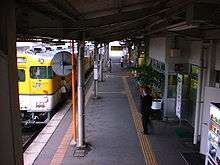Miyoshi Station (Hiroshima)
Miyoshi Station (三次駅, Miyoshi-eki) is a railway station in Miyoshi, Hiroshima, Japan, operated by West Japan Railway Company (JR West). Along with Niimi and Tsuyama Stations, Miyoshi is one of the major central region stations in the Chūgoku region of Japan.
Miyoshi Station 三次駅 | |
|---|---|
 Miyoshi Station in March 2016 | |
| Location | 1-1-1 Tōkaichi Minami, Miyoshi-shi, Hiroshima-ken 728-0014 Japan |
| Coordinates | 34°48′10″N 132°51′21″E |
| Operated by | |
| Line(s) | |
| Connections | Bus terminal |
| Other information | |
| Website | Official website |
| History | |
| Opened | 1 June 1933 |
| Previous names | Bingo Tōkaichi (until 1954) |
| Traffic | |
| Passengers (FY2009) | 664 daily |
| Location | |
 Miyoshi Station Location within Japan | |
Lines
Miyoshi Station is served by the Geibi Line and Fukuen Line, and is the terminal station for Fukuen Line.
It was also the terminal station for Sankō Line before the line ceased operation on 31 March 2018.
Station layout


Miyoshi Station is a reinforced concrete two-story building, operated by JR West. It features two platforms which handle four lines: one platform next to the station building and an island platform accessible via an enclosed footbridge above the tracks. The station building houses a small convenience store as well as automatic ticket vending machines and a "Midori no Madoguchi" staffed ticket office. There is a large waiting area inside the station building, as well as enclosed and unenclosed waiting areas on the platforms.
Platforms
- Platform 1: Geibi Line (for Hiroshima and Niimi), Fukuen Line (for Fuchū)
- Platform 2: Geibi Line (for Hiroshima or Niimi), Fukuen Line (for Fuchū)
- Platform 3: Geibi Line (for Hiroshima or Niimi), Fukuen Line (for Fuchū)
Adjacent stations
| « | Service | » | ||
|---|---|---|---|---|
| Geibi Line | ||||
| Terminus | Rapid Miyoshi Liner | Kōtachi | ||
| Yatsugi | Local | Nishi Miyoshi | ||
| Fukuen Line | ||||
| Yatsugi | - | Terminus | ||
History
The station opened on 1 June 1933, initially named Bingo Tōkaichi Station (備後十日市駅).[1] On 10 December 1954, the station was renamed Miyoshi.[1] With the privatization of Japanese National Railways (JNR) on 1 April 1987, the station came under the control of JR West.[1]
The turntable located next to the station was sold to the private railway operator Tobu Railway in 2016, and installed next to Kinugawa-Onsen Station in Tochigi Prefecture for use by steam-hauled tourist trains.[2]
The station was a terminal station of the Sankō Line. On 16 October 2015, JR West announced that it was considering closing the Sankō Line due to poor patronage.[3] On 29 September 2016, JR West announced that the entire rail line would close on 31 March 2018.[4] The line then closed on March 31, 2018, with an event hosted by JR West[5] and will be replaced by a bus service.[6]
Surrounding area
- Miyoshi Post Office
- Miyoshi CC Plaza shopping center
- Sungreen shopping center
- Miyoshi Municipal Tōkaichi Junior High School
- Miyoshi Municipal Tōkaichi Elementary School
- Basen River
- Gōno River
- Chūgoku Expressway Miyoshi Interchange


See also
References
- Ishino, Tetsu, ed. (1998). 停車場変遷大辞典 国鉄・JR編 [Station Transition Directory - JNR/JR]. II. Japan: JTB. p. 266. ISBN 4-533-02980-9.
- 蒸気機関車(SL)復活運転の車両・施設計画概要について [Details of rolling stock and facilities planned for steam locomotive operation] (pdf). News release (in Japanese). Japan: Tobu Railway. 21 April 2016. Retrieved 23 April 2016.
- JR西:三江線、廃止も検討…人口減、利用低迷で [JR West considering closure of Sanko Line - declining population and poor patronage]. Mainichi Shimbun (in Japanese). Japan: The Mainichi Newspapers. 16 October 2015. Archived from the original on 2 November 2015. Retrieved 6 February 2018.
- 三江線18年3月末で廃線 [Sanko Line to close at end of March 2018]. Mainichi Shimbun (in Japanese). Japan: The Mainichi Newspapers. 29 September 2016. Archived from the original on 1 October 2016. Retrieved 6 February 2018.
- "Railway fans bid JR Sanko Line in western Japan farewell as red ink forces closure". Mainichi Daily News. 31 March 2018. Retrieved 10 September 2018.
- JR三江線廃止 代替バス運行開始 Retrieved 2 April 2018 (in Japanese)
External links
| Wikimedia Commons has media related to Miyoshi Station (Hiroshima). |
- JR West station information (in Japanese)